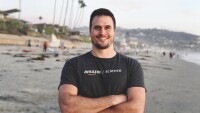Parmida Beigi’s career has touched many facets of machine learning and data science. From her PhD research in computer vision and time series forecasting to her work in Alexa AI end-to-end systems.
Today, Beigi pursues—among other things—speech recognition and natural language processing initiatives to help Amazon’s Alexa customers through her work on the local info team. Beigi has led efforts to improve the relevance and ranking of device search traffic (eg queries like “Where is the Lions Gate Bridge?”).
As a senior ML practitioner, Beigi says she feels it’s part of her mission to demystify her field for everyone.
The evidence of her passion for helping others is impressively public. Beigi answers questions and gives practical advice on his popular social media, such as Instagram, LinkedIn and Twitter feeds. Using simple graphics, quick clips and the handle @bigdataqueen, Beigi invites followers into her daily life and expertise as a machine learning researcher at Amazon.
To date, generous knowledge sharing has garnered her close to 100,000 followers. But her journey to ML researcher/social media maven wasn’t always an obvious one.
At first she thought she could follow in her family’s footsteps and become a doctor. Today she works on ML/AI projects related to spoken language understanding and information retrieval and ranking. So Beigi relates to people who are figuring out their professional path – not so long ago she did the same.
Discovering Data Science
In high school, Beigi first focused on science as a stepping stone to pre-med programs. But something was missing. Her natural interests ran more towards mathematics and computing, and she began to move in that direction, earning a bachelor’s degree in electrical and computer engineering.
In college, Beigi took classes that sparked her interest in digital signal processing. While earning her Masters in Electrical and Computer Engineering, she focused her research on compression sensing, signal processing, and image/video processing, allowing her to hone her skills in a practical context.
But Beigi had not completely skipped over the health field after all. One of her internships involved a research collaboration between the University of British Columbia (UBC) and the BC Cancer Research Center. In that case, the signal processing involved measuring specific biomarkers in patients’ breath with chemo-resistive sensors and then using statistical methods to look for specific associations between lung cancer and smoking habits.
“At the time, I didn’t know that I was already building the foundation for my career in machine learning,” says Beigi.
“The part of signal processing that really interested me was extracting the information embedded in the signals through time-frequency and spatiotemporal representations,” she says, adding that she loved “being able to solve difficult problems and improve human lives.”
Beigi presented his research at the BCCRC Health Sciences Conference and received the award for best speaker. This work also resulted in a journal paper published in IEEE Transactions on Biomedical Engineering.
Stitched by machine learning
She continued at UBC for her Ph.D. in electrical and computer engineering. Her first few years she worked with computer vision and artificial intelligence – and became more and more attracted to machine learning.
Whenever ML came across journal submissions that she reviewed or conferences that she attended, such as ICASSP and CVPR, she became fascinated by its vast applications, so she began to dig deeper.
“I read a lot of newspapers, took several online courses and listened to podcasts, although there weren’t many at the time – whatever tool I could find,” she says. “I set up my research environment so that I could develop simple ML-based methods based on the data I collected for my thesis to see how it would perform compared to the conventional rule-based techniques that we used before.”
She was hooked.
Beigi realized that she could learn much more about practical machine learning by integrating it into her research, where it could be used to solve a real-world problem.
She began working with two hospitals in Vancouver, Canada, where she realized there was a need to create technology for image-guided procedures that would enable doctors to ensure accurate placement of epidural needles—which is notoriously difficult.
By analyzing a stream of ultrasound images taken from a patient’s back as the anesthesiologist inserted a needle, Beigi developed a tool that used image processing techniques along with time series analysis and ML to visualize and locate that needle for the doctor.
Beigi published and presented her research in several peer-reviewed journals and conferences, including her ML-based tracking work, which was published in the International Journal of Computer Assisted Radiology and Surgery. She was also the recipient of an NSERC Alexander Graham Bell Fellowship awarded to top Canadian PhD scholars.
After defending her thesis, she took a job as an ML researcher at Boeing, leveraging her sensor processing expertise to work on predictive and prescriptive maintenance for Boeing aircraft.
Starts on social
This is also where she began her social media journey.
“I started sharing my experiences as a self-taught ML researcher to give back to the community and empower aspiring tech talent,” says Beigi. “I wasn’t really taught ML in school. During my early graduate studies, when I finished my research and teaching assignments, I studied machine learning on my own.”
It’s this personal DIY experience that makes her content so relatable.
Which university degrees are best for a career in AI or data science? Is self-supervised learning really just a fancy name for unsupervised learning? How do you get started coding machine learning in Python?
Beigi says the most common questions she answers are about how to get into data science and ML, and people asking if they can still get into the field without a PhD.
“Data science is not limited to technology, all industries are starting to benefit from data science and AI solutions,” she replies. “Typically for a DS/ML generalist you don’t need a PhD or necessarily a degree in computer science or computer science, these can only help you get shortlisted, but the most important thing is whether you can get the job done.”
She also helps by providing specific details, drilling down into what skills are needed for the job, regardless of degree.
As she expanded her social presence, she also began to consider a move. She knew her next step would be in the US – specifically to Silicon Valley.
She decided to “do more research, gain more targeted knowledge and practical hands-on experience through side projects, and then look for jobs that weren’t necessarily closely related to my PhD work, that would challenge me on both the practical and technical side.”
That’s how she ended up at Amazon.
Works at Amazon
Beigi interviewed at a few companies during her job search, and after considering competing offers, she decided to join Amazon in 2019. More than three years later, she hasn’t looked back.
“While staying with the same team for three years, I’ve had the luxury of applying data science across a variety of verticals, which is a part of my experience at Amazon that I really love,” she says. “It’s always Day 1 at Amazon, and customers are at the center of everything we do. Starting with customers and working backwards, I get to work with end-to-end Alexa components, starting from speech recognition, to natural language understanding, all the way to the final stage where we optimize relevance to best address customer queries through learning to ranking techniques.”
Since joining Amazon, Beigi has been a member of Amazon’s mentoring program and has consistently worked to raise the bar for scholarly publications as an AMLC reviewer.
“A great data scientist is curious, they look at the science behind everything, how and why things work, and identify patterns, correlations and causation. Just like a data science project itself, right?” she says. “Like science, data science is a broad term. Find the kind of data science that suits you – you know more than you think you do.”

